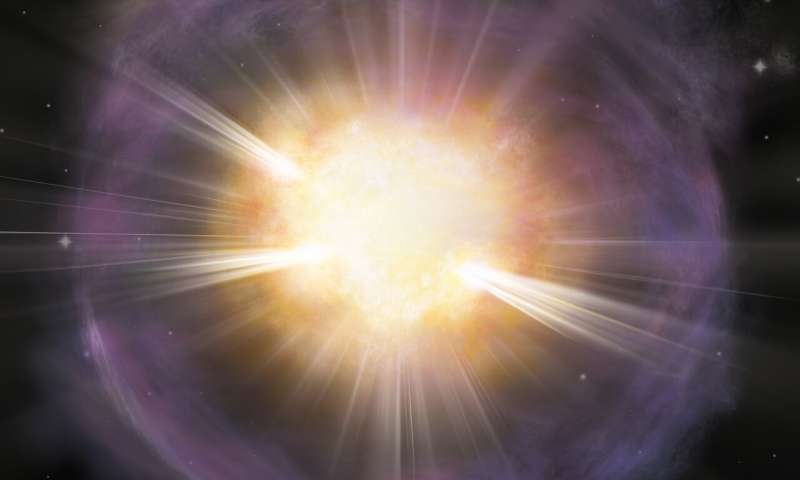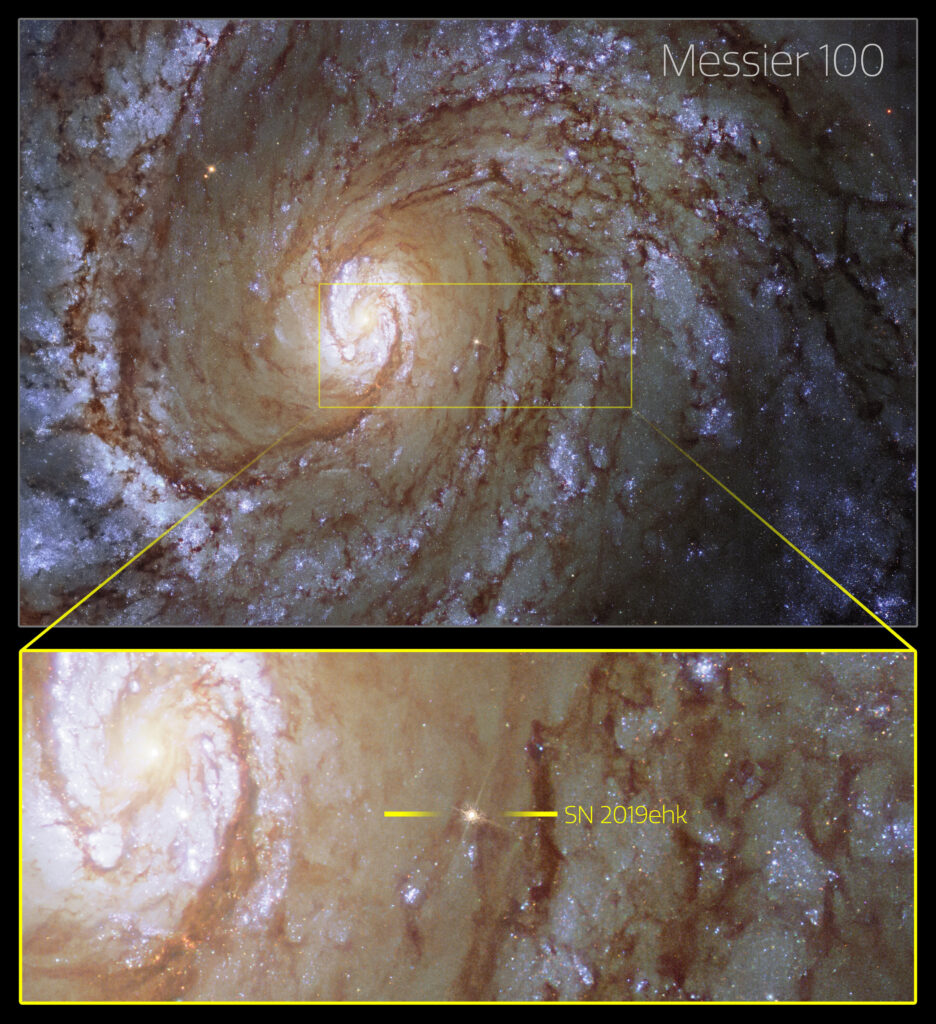Half of all the calcium in the universe—including the very calcium in our teeth and bones—was created in the last gasp of dying stars. Called “calcium-rich supernovae,” these stellar explosions are so rare that astrophysicists have struggled to find and subsequently study them. The nature of these supernovae and their mechanism for creating calcium, therefore, have remained elusive.

Now a Northwestern University-led team has potentially uncovered the true nature of these rare, mysterious events. For the first time ever, the researchers examined a calcium-rich supernova with X-ray imaging, which provided an unprecedented glimpse into the star during the last month of its life and ultimate explosion.
The new findings revealed that a calcium-rich supernova is a compact star that sheds an outer layer of gas during the final stages of its life. When the star explodes, its matter collides with the loose material in that outer shell, emitting bright X-rays. The overall explosion causes intensely hot temperatures and high pressure, driving a chemical reaction that produces calcium.
“These events are so few in number that we have never known what produced calcium-rich supernova,” said Wynn Jacobson-Galan, a first-year Northwestern graduate student who led the study. “By observing what this star did in its final month before it reached its critical, tumultuous end, we peered into a place previously unexplored, opening new avenues of study within transient science.”
“Before this event, we had indirect information about what calcium-rich supernovae might or might not be,” said Northwestern’s Raffaella Margutti, a senior author of the study. “Now, we can confidently rule out several possibilities.”
The research will be published on August 5 in The Astrophysical Journal. Nearly 70 co-authors from more than 15 countries contributed to the paper.
Margutti is an assistant professor of physics and astronomy in Northwestern’s Weinberg College of Arts and Sciences and a member of CIERA (Center for Interdisciplinary Exploration and Research in Astrophysics). Jacobson-Galan is an NSF Graduate Research Fellow in Margutti’s transients research group.
Amateur astronomer Joel Shepherd first spotted the bright burst, dubbed SN2019ehk, while stargazing in Seattle. On April 28, 2019, Shepherd used his new telescope to view Messier 100 (M100), a spiral galaxy located 55 million light years from Earth. The next day, a bright orange dot appeared in the frame. Shepherd reported the anomaly to a community astronomical survey.
“As soon as the world knew that there was a potential supernova in M100, a global collaboration was ignited,” Jacobson-Galan said. “Every single country with a prominent telescope turned to look at this object.”

This included leading observatories in the United States such as NASA’s Swift Satellite, W.M. Keck Observatory in Hawaii and the Lick Observatory in California. The Northwestern team, which has remote access to Keck, was one of the many teams worldwide who triggered its telescopes to examine SN2019ehk in optical wavelengths. University of California Santa Barbara graduate student Daichi Hiramatsu was the first to trigger Swift to study SN2019ehk in the X-ray and ultraviolet. Hiramatsu also is a staff scientist at Las Cumbres Observatory, which played a crucial role in monitoring the long-term evolution of this supernova with its global telescope network.
The worldwide follow-up operation moved so quickly that the supernova was observed just 10 hours after explosion. The X-ray emission detected with Swift only lingered for five days and then completely disappeared.
“In the world of transients, we have to discover things very, very fast before they fade,” Margutti said. “Initially, no one was looking for X-rays. Daichi noticed something and alerted us to the strange appearance of what looked like X-rays. We looked at the images and realized something was there. It was much more luminous than anybody would have ever thought. There were no preexisting theories that predicted calcium-rich transients would be so luminous in X-ray wavelengths.”
‘The richest of the rich’
While all calcium comes from stars, calcium-rich supernovae pack the most powerful punch. Typical stars create small amounts of calcium slowly through burning helium throughout their lives. Calcium-rich supernovae, on the other hand, produce massive amounts of calcium within seconds.
“The explosion is trying to cool down,” Margutti explained. “It wants to give away its energy, and calcium emission is an efficient way to do that.”
Using Keck, the Northwestern team discovered that SN 2019ehk emitted the most calcium ever observed in a singular astrophysical event.
“It wasn’t just calcium rich,” Margutti said. “It was the richest of the rich.”
Uncovering new clues
SN2019ehk’s brief luminosity told another a story about its nature. The Northwestern researchers believe that the star shed an outer layer of gas in its final days. When the star exploded, its material collided with this outer layer to produce a bright, energetic burst of X-rays.
“The luminosity tells us how much material the star shed and how close that material was to the star,” Jacobson-Galan said. “In this case, the star lost a very small amount of material right before it exploded. That material was still nearby.”
Although the Hubble Space Telescope had been observing M100 for the past 25 years, the powerful device never registered the star—which was experiencing its final evolution—responsible for SN2019ehk. The researchers used the Hubble images to examine the supernova site before the explosion occurred and say this is yet another clue to the star’s true nature.
“It was likely a white dwarf or very low-mass massive star,” Jacobson-Galan said. “Both of those would be very faint.”
“Without this explosion, you wouldn’t know that anything was ever there,” Margutti added. “Not even Hubble could see it.”
Reference scientific paper: “SN2019ehk: A double-peaked Ca-rich transient with luminous X-ray emission and shock-ionized spectral features,” Astrophysical Journal (2020).
arxiv.org/abs/2005.01782
Source: phys.org
